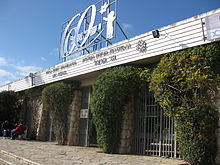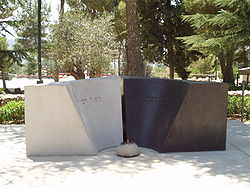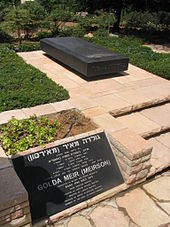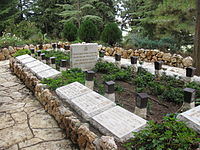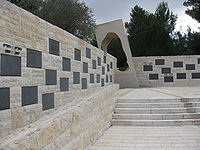- Mount Herzl
-
Mount Herzl (Hebrew: הר הרצל), also Har HaZikaron (Hebrew: הר הזכרון lit. "Mount of Remembrance"), is the national cemetery of Israel on the west side of Jerusalem. It is named for Theodor Herzl, the founder of modern political Zionism. Herzl's tomb lies at the top of the hill. Yad Vashem, which commemorates the Holocaust, lies to the west of Mt. Herzl. Israel's war dead are also buried there. Mount Herzl is 834 meters above the sea.
Contents
History
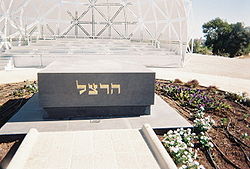 Theodor Herzl's grave
Theodor Herzl's grave
Mount Herzl has served as Israel's national cemetery since 1951, following a government decision to establish a cemetery for Israeli leaders and fallen soldiers. Mt. Herzl is the burial place of three of Israel's prime ministers: Levi Eshkol, Golda Meir and Yitzhak Rabin (who is buried beside his wife Leah). Israeli presidents are also buried on Mt. Herzl, as are other prominent Jewish and Zionist leaders. Mt. Herzl is the venue for many commemorative events and national celebrations.
Helkat Gedolei Ha'Uma
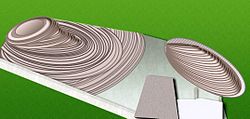 Illustration of the National Memorial Hall as shape of a torch
Illustration of the National Memorial Hall as shape of a torch
In 1934, Zionist leader Menahem Ussishkin organized the re-interrment of Leon Pinsker in Nicanor Cave on Mount Scopus in an attempt to build a pantheon for the great leaders of the nation. Ussishkin was buried there himself in 1941. When Mount Scopus became an enclave, cut off from Jerusalem, this solution was no longer feasible. A site was thus set aside for state leaders on Mount Herzl. The Presidents of Israel, Prime Ministers of Israel, and Knesset speakers are buried there. To the north of Herzl's grave, is a plot reserved for the leaders of the World Zionist Organization, among them David Wolffsohn, Nahum Sokolow, Simcha Dinitz, and Arieh Dulchin. Herzl's children - his daughter Pauline and son Hans - are buried nearby. Zalman Shazar, Chaim Herzog, Levi Eshkol, Golda Meir, Yitzhak Rabin and his wife Leah Rabin are buried there. Other notable graves are those of the first speaker of the Knesset, Yosef Sprinzak and his wife Hanna, the first Minister of Finance, Eliezer Kaplan, and Jerusalem mayor Teddy Kollek. The grave of Ze'ev Jabotinsky and his family is in a separate plot on the west side of Helkat Gedolei Ha'Uma.
Despite the national significance of the cemetery, some Israeli leaders asked to be buried elsewhere. David Ben-Gurion, the first Prime Minister of Israel, chose to be laid to rest in Sde Boker, the kibbutz to which he moved in keeping with his vision of cultivating the arid Negev desert. Menachem Begin left instructions that he wanted to be buried on the Mount of Olives, beside two members of the Irgun pre-state underground who were hung by the British. Chaim Weizmann, the first President of Israel, chose to be buried in his estate in Weizmann Institute of Science in Rehovot, and the seventh President of Israel, Ezer Weizman was buried next to his son in Or Akiva. Yitzhak Ben-Zvi, the second president of Israel, asked to be buried in Har HaMenuchot cemetery, and Moshe Sharett, the second prime minister of Israel, was buried in Trumpeldor cemetery in Tel Aviv. Ephraim Katzir, the fourth president of Israel, chose to be buried alongside his wife Nina in the Rehovot cemetery.
Criteria for burial
Deciding who merits burial on Mt. Herzl has sometimes been controversial.[1] For example, the decision to bury Ze'ev Jabotinsky, who died in 1940, on Mt. Herzl, was fiercely opposed by many Labour Party stalwarts, who claimed that Jabotinsky was an ultra-right nationalist undeserving of such an honor. Only in 1964 did Prime Minister Levi Eshkol decide in favor of burying him there, in the interest of promoting national reconciliation and setting aside political grievances.
Soldiers awarded with the Medal of Valor may also be granted the right to be buried in Helkat Gedolei Ha'Uma.
Garden of the Nations
Golda Meir's grave on Mount Herzl
In the southeast part of Mount Herzl plaza, above the Herzl Museum and the main entrance, is the "Garden of Nations," where trees have been planted by visiting presidents and heads of state.
National Military cemetery
Israel's main Israel Defense Forces cemetery is located on the northern slope of Mt. Herzl. Soldiers who have fallen in the line of duty are buried there. Israel's main Israel Police cemetery is located on the northern slope of Mt. Herzl. Israeli police officers who have fallen in the line of duty are buried there in the northern military cemetery.
The Garden of the Missing Soldiers is a garden commemorating IDF soldiers whose burial place is unknown. A National Memorial Hall is scheduled to open in 2013 featuring a new memorial to the Unknown Soldier.
The military cemetery also has a large plaza where a state ceremony is held on Yom Hazikaron, commemorating Israel's fallen soldiers. The National Memorial Hall is supposed to replace the Central Memorial Plaza ceremonies by the Yom Hazikaron in 2013.
Herzl's grave
 Menorah sculpture near main entrance
Menorah sculpture near main entrance
In 1903, Theodor Herzl wrote in his will:
- "I wish to be buried in a metal coffin next to my father, and to remain there until the Jewish people will transfer my remains to Eretz Israel. The coffins of my father, my sister Pauline, and of my close relatives who will have died until then will also be transferred there." [2]
When Herzl died a year later, he was interred in Vienna. Forty-five years later, Herzl's remains were brought to Israel and reinterred in Jerusalem. The location of the burial site was selected by a special state commission. Sixty-three entries were submitted in the competition for the design of the tombstone. The winner was Joseph Klarwein's design, consisting of an unadorned black granite stone inscribed with the name Herzl.
Despite Herzl's explicit wishes, his children were not buried beside him. For various reasons, the remains of his son and daughter were only brought to Israel in 2006.[3] A third daughter was murdered in the Holocaust and her place of burial remains unknown. Herzl's only grandson was reinterred on Mt. Herzl in December 2007.[4] Herzl's parents and sister are also buried at Mount Herzl.
The official ceremony marking the start of Israeli Independence Day is held in the large plaza next to Herzl's grave.
Other monuments and memorials
- Victims of Acts of Terror Memorial, commemorating all Israeli terror victims from 1851 until today.
- Memorial to Ethiopian Jews who were murdered on the way to Israel
- INS Dakar memorial
- 23 seafarers boat memorial
- Memorial to Jewish soldiers who fought with the Russian army in World War II
- Memorial to Jewish soldiers who fought with the Polish army in World War II
- Memorial to Jewish soldiers who fought with the British army in World War II in Palestine
- Monument to the residents of the Jewish Quarter in the Old City of Jerusalem who fell in 1948
- Monument to the last Last survivor of the Holocaust who had fallen in 1948 war
Herzl museum
An interactive museum on Mt. Herzl offers a glimpse into the life of Theodor Herzl, the man behind the dream of a Jewish homeland.[5] A Zionism Studies Center was opened in 2010 next to the museum.[citation needed]
Archaeology
Ancient Jewish burial cave from the Second Temple period
While expanding the cemetery in 1954, a Jewish burial cave was discovered from the Second Temple period.
See also
- List of National Cemeteries by country
References
- ^ Jewishsf.com, Who deserves burial on Israel's Mt. Herzl?
- ^ Mount Herzl and the Military Cemetery
- ^ Herzl's Children to be Interred on Mount Herzl
- ^ Theodor Herzl's only grandson reinterred in J'lem cemetery - Haaretz - Israel News
- ^ Jewishsf.com, - New Herzl Museum tells story of man behind Zionist dream.
External links
- Mount Herzl museum
- Find a grave on Mount Herzl
- Mount Herzl: The Creation of Israel's National Cemetery, Maoz Azaryahu
- Mount Herzl on WikiMapia
Coordinates: 31°46′26″N 35°10′50″E / 31.77389°N 35.18056°E
Categories:- Mountains of Jerusalem
- Jewish cemeteries in Jerusalem
- Cemeteries in Jerusalem
- Cemeteries in Israel
- Jewish cemeteries
- Military memorials and cemeteries
- Mountains of Israel
- Biographical museums in Israel
Wikimedia Foundation. 2010.

